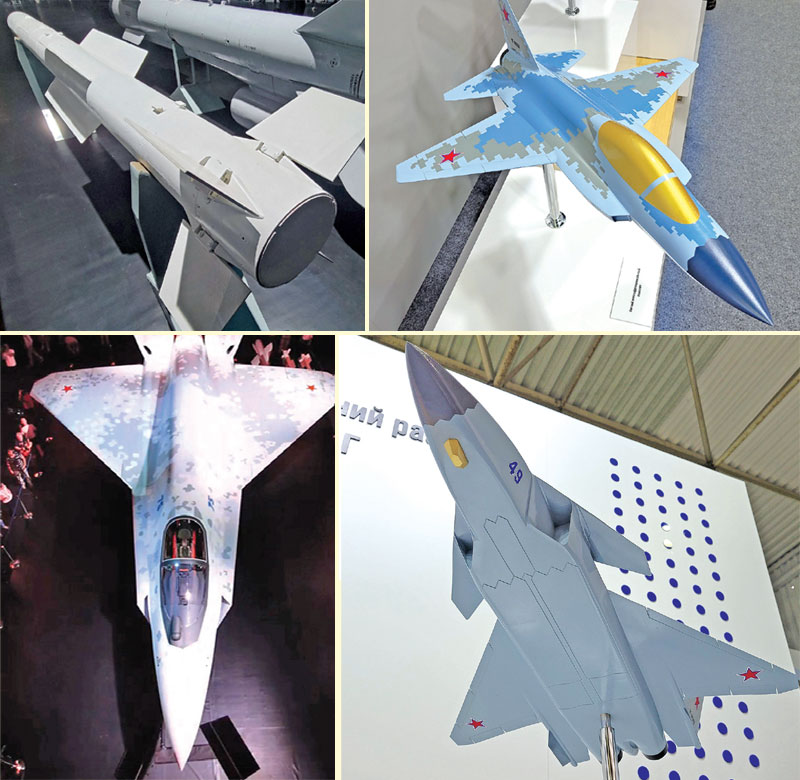MAKS 2021 unveils the possible forerunner to BRAHMOS-2
Prasun K. Sengupta
The 15th International Aviation and Space Salon (MAKS-2021) that was held from July 20 to 25 at the Zhukovsky, Moscow, hosted the exhibits of 538 Russian companies and 91 foreign participants from 20 countries. The expo’s hybrid format also enabled 202 foreign companies from 53 countries to take part. Thus, the expo was attended by 831 exhibitors from 56 countries.

State-owned holding company Rostec’s United Aircraft Corp. (UAC) subsidiary used MAKS-2021 to unveil the mock-up of a new stealthy multi-role combat aircraft MRCA, presently referred to as the LTS ‘Checkmate’, which is likely to be known later as the Su-75. A product of the Sukhoi Experimental design bureau (OKB), the full-scale model was marked with the registration ‘RF-0075’ and the Bort (side number) ‘Blue 75,’ indicating that the LTS would have the design bureau designation T-75.
However, Rostec was claiming that the LTS is ready for flight-tests. Shortly before the expo began, ROTEC had released an English-language teaser video, which alluded that the LTS is aimed at the export market, with Argentina, India, the UAE, and Vietnam being highlighted. The inclusion of the UAE was expected, since at the IDEX expo held in Abu Dhabi in February 2017, the UAE and Russia had inked an agreement on industrial cooperation on military projects, including the development of a new-generation MRCA. It is still unclear if the Russian aerospace forces have a requirement for such a MRCA. UAC had also shared on social media some long-range photographs of the aircraft being towed under black tarpaulins to a dedicated closed display hall. It was kept under wraps pending a presentation to Russian President Vladimir Putin by UAC president Yuri Slyusar on July 20, the opening day of the Expo.
Going by external looks, the LTS is considerably smaller and lighter than the Su-57, though there are some design similarities, such as the shape of the cockpit canopy. In terms of configuration, the LTS features a cropped delta wing, widely-splayed tail-fins, and does away with horizontal stabilisers. The moveable fins act as rudders, providing control in both pitches and yaw axes, while the sole turbofan has a multi-axis thrust-vectoring nozzle. The most striking design feature is the air-intake, which is an underslung chin-mounted inlet wrapped around the lower fuselage, but with a flat underside.
Slyusar revealed that a two-seat version and an unmanned derivative are also being considered. On either side of the forward fuselage are weapon bays for two short-range air-to-air missiles, while three longer-range weapons are carried in the lower bay. A gun-pack can be mounted in the main weapon bay, with the gun itself protruding below the fuselage. Maximum indicative weapons load is 7.4 tonnes, including a range of air-to-surface weaponry. Maximum takeoff weight (MTOW) will be around 18 tonnes. Maximum cruise speed is expected to be Mach 1.8, while range without external fuel-tanks is quoted as being 2,800km.
It is intended to supercruise—fly supersonically without the use of afterburner—and is rated for 8-G manoeuvring. The projected definitive powerplant is the NPO Saturn Izdeliye 30 turbofan, which is also being developed for the twin-engined Su-57. The LTS will have an open systems architecture and will also accommodate an automated logistics system known as Matreshka. Artificial intelligence technology will be employed to provide a self-checking function of the LTS to reduce pilot workload.
The cockpit will feature a wide-area panoramic AMLCD display and employ voice-control technology. A K-36D5 ejection seat with dual-mode heating and backrest tilt adjustment will be used. The distance to the pedals for the height of the pilot will be electrically regulated. There will also be a high-altitude suit temperature setting. The aircraft control stick will have a ‘manoeuvre’ button, which includes a controlled engine thrust vector, and, accordingly, a super-manoeuvrability mode.
UAC subsidiary Russian Aircraft Corporation (RSC) MiG revealed at the expo that it has begun development of a stealthy fifth-generation carrier-based M-MRCA. A scale-model of such an aircraft shown at the expo indicated that it will be twin-engined with reduced radar signature. The aircraft will be made according to the ‘duck’ aerodynamic configuration. There are strong reasons to expect that RSC-MiG is developing this naval MRCA to meet the Indian Navy’s requirement for fifth-generation twin-engined deck-based fighters (TEDBF), which are expected to be ordered by 2035. RAC-MiG also confirmed that the Indian Navy is presently negotiating the details of a mid-life upgrade package for its fleet of MiG-29K/KUB carrier-based fighters, which had entered service in 2010 and will be due for mid-life upgrades from 2023 onwards. Phazotron-NIIR’s Zhuk-AM active phased-array multi-mode radars are expected to replace the existing Zhuk-M2E mechanically-scanning radars.
You must be logged in to view this content.

